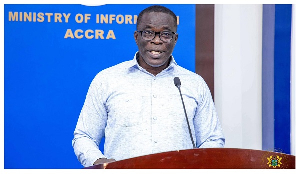Revisited :Does Our Educational System Allow Creativity in Early Childhood Development?
When one reads from www.ghanaweb.com: General News of Wednesday, 17 October 2007 ‘600 pupils learn under trees’Inadequate infrastructure at the Bethel Presby Junior High School at Atonsu, a Kumasi suburb, "has compelled the school authorities to be conducting academic work under trees in the school for a section of the pupils.
About 600 pupils from kindergarten to primary six are affected by the current exercise, and this is undermining academic work.
For the past two years that the storey building, which accommodated the pupils, caved in, the pupils have to be in school early enough to arrange their furniture under the trees for academic work to begin.
Anytime it rains, academic work in the school is suspended because the pupils have to join their senior colleagues in the other classrooms, compelling the teachers to suspend teaching.
Academic work under the trees is also affected when the weather becomes windy.
Yet let us reflect on the way Ghana celebrated its golden jubilee it was quite impressive. Fellow Ghanaians whilst we are busy partying, our backyards are full of children attending schools under trees.
I quote a comment from the article which says, "We are always at the mercy of the weather because anytime it rains the pupils have to vacate their place, remove the furniture and join their senior colleagues in their classrooms."
This alerts our nation that we have a real problem. In view of this I am attaching an old article I wrote some time ago .
In contrast, researchers have identified that a child’s first three years are critical for the development of language, attention span, social skills, and problem-solving capabilities.
Yes, given the importance of quality early childhood care, well-designed early childhood centres are lacking in Ghana.
Day care centres serving low-income children in the rural areas are so poorly run that they impede children’s health and safety. Could this be a Human right issue?
Comparing the ideal classroom size in the United States , which is 42-50 square feet per child with the minimum being 35 square feet per child, highlights the quality our children are getting! It is worth evaluating the quality of care our children would get in their current roofless classrooms or day care centres. I have not measured day care centre facilities but could we equate the square feet allowance for a child in our villages’ day care centre to the above? Whose responsibility is it therefore to see that every day care centre classroom all across Ghana is fully roofed with basic security for our children. At least meeting our children’s needs half way would be acceptable by UNICEF and other related organisations.
State Day Care Centres or nurseries in Ghana, do lack a more pragmatic flexibility to allow for children to play and engage in any creative activities.
It is important, as the theorists have researched, for classrooms to have a high degree of spatial differentiation as activity areas. There is the need to separate physical objects such as movable partitions, a screen and other activity objects. This distinction and well-defined boundaries does support social interaction, encourages exploratory behaviour, and prevent interruption of ongoing play.
Basically the above demonstrate the need for classrooms to have four distinct activity zones.
Gross-motor skill zone—This offer pre-school children the space to dance, climb, jump, and move things. This space needs to allow for push and pull toys
Dramatic play Zone- - Make believe and pretend play is important for pre school children. Providing home centre props, such as kitchen, living room furniture, and Theatre area. Such a space allows for gross motor movement between the two zones. This division facilitates the promotion of a sense of semi-private space.
Arts and crafts zone- This is the wet area of the room where pre-school children can experiment with sand, water, paint, paste, clay and other messy materials. The art and craft zone needs to be near a water source.
Quiet zone—: Young children need personal space that permits intimate interaction with an adult and provides a space for solitary play, looking at books, or simply resting. This is an area that perhaps a mini library could be installed.
Outdoor space-: An outdoor space should allow for both free and structural play. Such as seesaw, tyres for pull along games, bike, and playground equipment that other safety equipment to prevent major accidents and injuries. Currently most of such rural day care centres have practically no playing equipments to talk of, Or are there any?
Multipurpose room-: This would serve as a dinning room and could even be an open summer hut
There should be a mini health centre with staff trained to provide first aid.
Teacher’s workspace-: This area provides space for teacher preparation and relaxation. This is a space for collaborative planning with perhaps TV & Video. Ghanaians in the diaspora could help in this regard by donating such equipment to be used in such facilities that may be setup in the villages. Administrative space-: This is for administrative purposes.
Why, the need for proper designing of Day care centres
Children progress rapidly through physical, cognitive, and socio-emotional development. Some implications for design include providing a safe environment and space for day care workers to interact with the children.
Discovery and Play-: The environment should permit growth and discovery. Our children need the space where they feel both autonomous and masterful. However do our State day care centres provide this vital space to facilitate this development?
The wealthy group within our society have options and may send their children off to Montessori purposeful designed day care centres. However, the poor, vulnerable and disadvantage group have no option other than send their children to the dilapidated, day care centres. Some centres have leaking roofs or no roofs or “ under the tree day care centre”. Is this all we could offer the children in our villages?
Where are the children human rights and child protection policies? There seems to be a failure on the part of the state to provide and enforce such policies. It appears these children are being denied the basic education they need for a solid foundation necessary to enable them to reach their full potential. Does the UNICEF educational funds, and other major educational organisations consider these requirements before providing funds to such centers?.
Early learning centres have been viewed by educators as a vital component in preparing children to come to school ready to learn, gain self belief, self-esteem and resulting to confident, assertive children and ready to face the wicked world out there.
On the contrary, when one goes to our villages, one sees children looking very timid, shy, no confidence look in their eyes. One wonders what the future holds for them. Very bleak indeed.
Could this mean that there is lack of creativity in our early years educational strategic planning? In an ideal world, our educational system may require to integrate basic skills such as playing with clay and encouraging pottery, doll making, painting, using of scissors for paper cutting, basic art and craft, textile cutting, children Theatre, bead making, sand, water and playing with mud. Also introducing the art of mosaic using just odd broken tiles would widen the cognitive skills of our children.
Introducing jigsaw puzzles with card games at all day centres would help to offer creativity and early cognitive development of our children.
Are these too much to ask for our socio-economically-disadvantaged children? I hope the Minister of education, could clearly spell out his strategic plans for day care centres to the general public and reassure parents in this specific category. As these groups are unable to articulate what is best for their children?
Which target group of children does the Government have in their strategic planning for our future workforce though? .
Does the Government assumed that all children go to top quality day care centres, which provides a desired facility?
Where does each region’s MP send their children of nursery going age?
Is it in a dilapidated day care centre similar to those in our villages?
Whose responsibility is it then, to ensure a proper provision for the very poor, vulnerable children of Ghana?
Whose needs are put on the negotiating table when it comes to securing foreign loans for educationl development?
The quality of day care centres is becoming an important political, educational, and social concern globally. As research mounts on the importance of the first years of life. It is therefore about time Ghana Government and the individual care day centres, to remember that early childhood day care centre is a crucial component of the quality of care offered to our children regardless of their social-economic background.
Such children are the backbone of Ghana’s future workforce and the key to our total freedom from that label “ poverty stricken country”
I am pleading with the Ghana Government, NGO’s, the individual nursery owners to rethink about the strategic planning of day care centres, with a mission to establish a solid foundation for the nation’s future workforce. As a nation we should not let these vulnerable, socio-economic deprived children down.
How could we as a nation boost our human resources to achieve a decent standard of living for our people? Unless the needs of these groups of children are fully addressed, Ghana would be classified in the eyes of the developed world as a poor country needing more aid and loans to sustain it.
We as a nation are responsible to offer this head start in life to our vulnerable group of children
The UNICEF, United Nations, Human rights regulations must all pull together and ensure that the Government demonstrates that money meant of such development are used as planned.
All chiefs, community leaders, churches, Mosques and the individuals must endeavour to be the mouthpiece for our voiceless infants in the villages.
All one needs to know is whether “ the poverty reduction money “cover these areas of concern too?
In view of the above concerns ,Ghana as a nation is rather focused on building a purposeful Presidential Palace to impress the outside world that all is well with Ghana. We have a real problem as we are failing to prioritize basic necessities crucial for the developemnt of our future workforce.



















